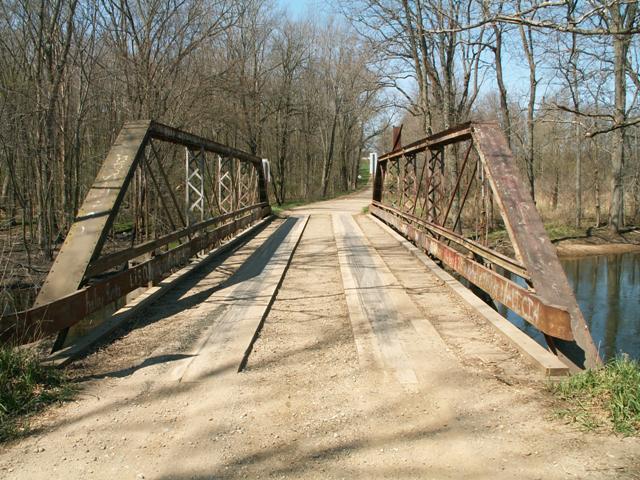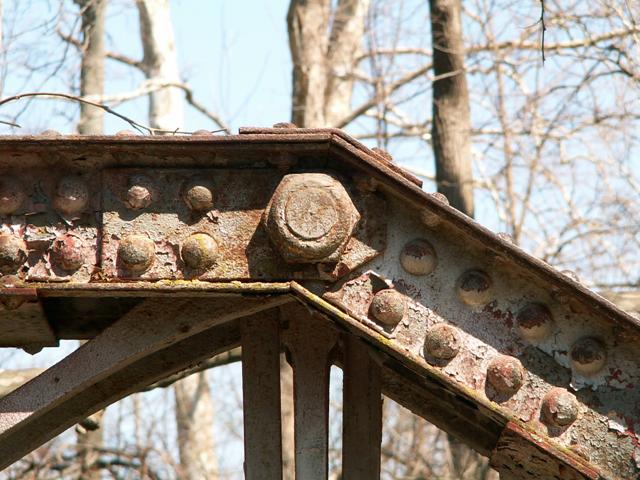We Recommend:
Bach Steel - Experts at historic truss bridge restoration.
BridgeHunter.com Phase 1 is released to the public! - Visit Now
Gower Road Bridge

Primary Photographer(s): Nathan Holth
Bridge Documented: 2004, Spring 2007, and March 4, 2022
Rural: Branch County, Michigan: United States
By Builder/Contractor: Massillon Bridge Company of Massillon, Ohio
Not Available or Not Applicable
77.8 Feet (23.7 Meters)
81.0 Feet (24.7 Meters)
13 Feet (3.96 Meters)
1 Main Span(s)
12316H00014B010

View Information About HSR Ratings
Bridge Documentation
This bridge's future is at risk!
Bridge Status: This bridge has been closed to traffic, and as of 2021 is slated for demolition without replacement in FY 2022! Local Agency Bridge Bundling Program.Among the most significant bridges in Branch County is this impressive pin connected Pratt pony truss. Even more surprising is that it is open to vehicular traffic, something that has become a rarity in Michigan! There is an unusual piece of steel mounted on the north top chord of the bridge. Although not original, it appears that it may have been holding a sign. There is no plaque on the bridge today, however the outline of a standard Massillon plaque remains. Also of interest, although one section of railings are not original, the top set of railings appear to be original. At first glance these original railings appear newer due to the channel-like design to them... but a close look reveals they are all riveted, an unusual rolled shape, and likely original. The shape of them is similar to what some prototypes of modern Armco Railing might have looked like. The fact is this is a unique railing used exclusively by the Massillon Bridge Company in the 1880s. It appears to be a rolled section of a Keystone column. If true, this would be the only known example of any form of Keystone column material in the state of Michigan, since no complete columns are found in Michigan.
There is v-lacing present on the verticals, and the deck of the bridge is wooden. The wooden deck appears to have been redone fairly recently (when visited in 2007). The bridge is a six panel structure. The bridge is seated on concrete abutments. The abutments have had newer concrete added to parts of them.
The Michigan Historic Bridge Inventory provides the following technical data: Features of the bridge include: upper chord: back-to-back channels with cover plate and battens; lower chord: paired bars; two outer verticals: rod with turnbuckle between paired bars; three middle verticals: back-to-back channels with v-lacing on both sides; two diagonals extending from the center of upper chord to lower chord: square bars with turnbuckles; other diagonals: paired square bars; railings: guardrail sections with large channel sections below them; bottom laterals: crossed rods; floor beams: built-up i-beams consisting of two pairs of back-to-back angles with a cover plate between them, u-bolt bolted to superstructure.
The bridge as seen in 2022 after it had been closed for a number of years is striking, it is hard to believe it was still open to traffic in 2007. The timber deck and non-original steel deck stringers are severely deteriorated. The 1880s wrought iron truss remains in decent condition however and the abutments showed no signs of putting the bridge at risk for collapse.
Additional Notes On Railing
HistoricBridges.org consulted with James Stewart, an engineer with an interest in historic bridges. His thoughts on the railing after measurements were taken: It looks like a 6" diameter Keystone Column, (Catalog diameters for columns included 10, 8, 6, and 4). Rolling a similar shape would have been a lot of work and very impractical, without a very large order. He suspects that special rolled shapes of iron were possible, but again not common unless a large order was needed. His opinion is that its most likely that the railing is a Keystone column but there is a slight possibility that it was a custom rolled iron section.
Demolition: The Shame of Michigan
The COVID-19 pandemic was a terrible event, and it is understandable that numerous programs were put into place to keep the economy going and to recover from the impact of the pandemic. One such program was for the federal government to give a bunch of money to MDOT. Rather than use this money to repave Michigan's roads, which are far worse on average than almost every other state in the country, or use this money to perhaps improve communities most severely impacted by COVID-19 such as low income cities like Detroit or Flint, MDOT and the county road commissions decided a great way to recover from COVID-19 was to waste this money annihilating a record-breaking number of historic bridges in Michigan, one of the greatest atrocities against historic bridges in Michigan since this website began in 2002! This fact must be absolutely clear: Michigan has far less surviving historic metal truss bridges than surrounding states like Indiana, Ohio, and even the Canadian province of Ontario. Each surviving truss bridge is today rare. Yet under this program, multiple historic metal truss bridges have been targeted for demolition, including bridges that are not being used and will simply be demolished without replacement. This includes the Gower Road Bridge. You heard correctly, they will be using this money to demolish a bridge that is historic, contains Keystone column railings, is from the 1880s and is of wrought iron construction which is highly resistant to rust. Section 106 should apply to this program and HistoricBridges.org will do its best to fight these plans. This nonsense is something one might expect from Missouri or Maine, states which treat historic metal truss bridges like an infestation of cockroaches that must be eliminated at all costs. Michigan used to be better than this. Michigan once led the way with the first Historic Bridge Park in the country and was one of the first states to standardize the use of hot riveting and pack rust removal in historic truss bridge rehabilitation. Now, Michigan seems ready to join the worst states in the country by engaging in one of the most ridiculous wastes of taxpayer dollars ever conceived. This bridge is NOT at risk of collapse. At the very minimum the bridge should be "monumented" with the deck stringers and timber deck removed, left in place abandoned. Many bridges in Michigan have been left abandoned for decades with no problems, as well as in other states like Tennessee and Texas where "monumenting" was common. And here is a really revolutionary idea: Why not hire a local, Michigan-based company like Bach Steel to relocate and restore this bridge for pedestrian use on a trail or in a park, rather than build yet another one of those eyesore, cheap, mass-produced (and short-lived) pre-fabricated modern trusses that are like the black plague on trail systems today? At the very very least, the author of this website drove on paved roads to get to this bridge that were so riddled with potholes that it looked post-apocalyptic that MDOT and the county road commissions should hang their heads in shame for choosing to wipe historic bridges NOT IN THE WAY OF ANYTHING off the face of the earth while leaving third world quality roads as-is. This is absolutely shameful.
View Archived National Bridge Inventory Report - Has Additional Details and Evaluation

Above: Bridge in 2022. Photo Credit: Jason Holloway
Below: The photos were taken on a county road north of this bridge. The money intended for COVID recovery that is being used to wipe this bridge off the face of the earth could have instead been used to repave this road which is in far worse condition than the majority of roads in developing countries like Vietnam for example. Which would benefit taxpayers more? Repaving a county road or destroying a historic bridge without replacement that is not at risk for collapse?


This bridge is tagged with the following special condition(s): Available and Unorganized Photos
![]()
Photo Galleries and Videos: Gower Road Bridge
Original / Full Size Gallery
Original / Full Size PhotosFor the best visual immersion and full detail, or for use as a desktop background, this gallery presents selected overview and detail photos for this bridge in the original digital camera resolution. This gallery offers photos in the highest available resolution and file size in a touch-friendly popup viewer.
Alternatively, Browse Without Using Viewer
![]()
Structure Overview
Mobile Optimized PhotosA collection of overview photos that show the bridge as a whole and general areas of the bridge. This gallery features data-friendly, fast-loading photos in a touch-friendly popup viewer.
Alternatively, Browse Without Using Viewer
![]()
Structure Details
Mobile Optimized PhotosA collection of detail photos that document the parts, construction, and condition of the bridge. This gallery features data-friendly, fast-loading photos in a touch-friendly popup viewer.
Alternatively, Browse Without Using Viewer
![]()
Additional Unorganized Photos
Original / Full Size PhotosThis photo gallery features both post-2007 photos and older ca. 2003-2006 photos taken when the website only included a few photos in original size on the website, and a smaller quantity of reduced size photos as well. This unorganized gallery may partially duplicate photos in other galleries on this bridge's page, however all photos here are available in the Original / Full Size. This gallery offers photos in the highest available resolution and file size in a touch-friendly popup viewer.
Alternatively, Browse Without Using Viewer
![]()
Additional Unorganized Photos
Mobile Optimized PhotosThis photo gallery features both post-2007 photos and older ca. 2003-2006 photos taken when the website only included a few photos in original size on the website, and a smaller quantity of reduced size photos as well. This unorganized gallery may partially duplicate photos in other galleries on this bridge's page, however all photos here are available in the Original / Full Size. This gallery features data-friendly, fast-loading photos in a touch-friendly popup viewer.
Alternatively, Browse Without Using Viewer
![]()
Maps and Links: Gower Road Bridge
Coordinates (Latitude, Longitude):
Search For Additional Bridge Listings:
Bridgehunter.com: View listed bridges within 0.5 miles (0.8 kilometers) of this bridge.
Bridgehunter.com: View listed bridges within 10 miles (16 kilometers) of this bridge.
Additional Maps:
Google Streetview (If Available)
GeoHack (Additional Links and Coordinates)
Apple Maps (Via DuckDuckGo Search)
Apple Maps (Apple devices only)
Android: Open Location In Your Map or GPS App
Flickr Gallery (Find Nearby Photos)
Wikimedia Commons (Find Nearby Photos)
Directions Via Sygic For Android
Directions Via Sygic For iOS and Android Dolphin Browser
USGS National Map (United States Only)
Historical USGS Topo Maps (United States Only)
Historic Aerials (United States Only)
CalTopo Maps (United States Only)



